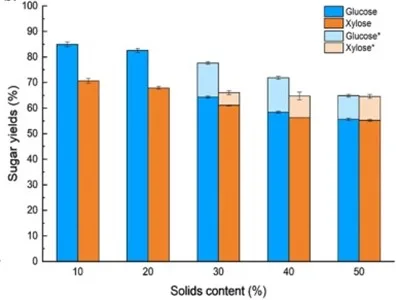High Solids Loading Biorefinery for the Production of Cellulosic Sugars from Bioenergy Sorghum
Themes: Conversion
Keywords: Feedstock Bioprocessing
Citation
Cheng, M-H., Jawad Kadhum, H., Murthy, G.S., Dien, B.S., Singh, V. Aug. 26, 2020. “High Solids Loading Biorefinery for the Production of Cellulosic Sugars from Bioenergy Sorghum.” Bioresource Technology. DOI: 10.1016/j.biortech.2020.124051.
Overview

A novel process applying high solids loading in chemical-free pretreatment and enzymatic hydrolysis was developed to produce sugars from bioenergy sorghum. Hydrothermal pretreatment with 50% solids loading was performed in a pilot scale continuous reactor followed by disc refining. Sugars were extracted from the enzymatic hydrolysis at 10% to 50% solids content using fed-batch operations. Three surfactants (Tween 80, PEG 4000, and PEG 6000) were evaluated to increase sugar yields. Hydrolysis using 2% PEG 4000 had the highest sugar yields. Glucose concentrations of 105, 130, and 147 g/L were obtained from the reaction at 30%, 40%, and 50% solids content, respectively. The maximum sugar concentration of the hydrolysate, including glucose and xylose, obtained was 232 g/L. Additionally, the glucose recovery (73.14%) was increased compared to that of the batch reaction (52.74%) by using two-stage enzymatic hydrolysis combined with fed-batch operation at 50% w/v solids content.
Data
Download (6.9 KB) includes:
- Sugar yields
- Biomass Loading Pattern